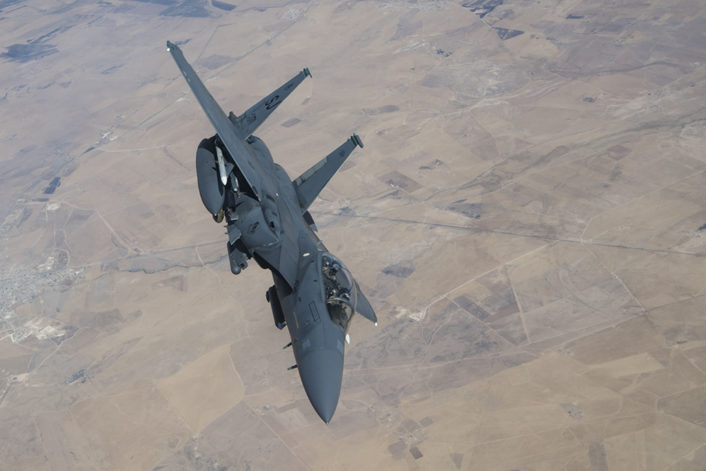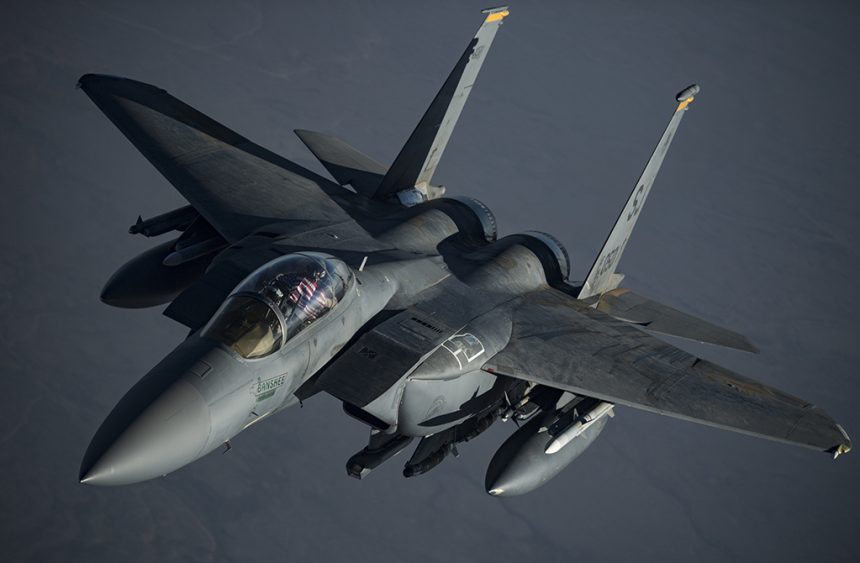U.S. F-15E bombed Lafarge Cement Factory, an anti-ISIS base in northern Syria, because Turkey-backed fighters closed in.
Two U.S. Air Force F-15E Strike Eagle aircraft supporting Operation Inherent Resolve, carried out an air strike on Lafarge Cement Factory, to destroy an ammunition cache and prevent it from being seized by Turkish-backed Free Syrian Army, or TFSA, that along with the Turkish forces continue to move south with the goal of uprooting the Kurdish fighters, which Turkey views as terrorists that threaten its national interests.
On Oct. 16, after all #Coalition personnel and essential tactical equipment departed, two Coalition F-15Es successfully conducted a pre-planned precision airstrike at the Lafarge Cement Factory to destroy an ammunition cache and reduce the facility’s military usefulness.
— OIR Spokesman Col. Myles B. Caggins III (@OIRSpox) Oct. 16 2019
According to Col. Myles B. Caggins III, OIR Spokesman, the US-led coalition forces had just completely vacated the Lafarge Cement Factory, in northern Syria, as part of the withdrawal of forces that follows U.S. President Donald Trump’s tacit approval to Recep Tayyip Erdogan to launch an invasion into northern Syria.
#Coalition forces continue a deliberate withdrawal from northeast #Syria. On Oct. 16, we vacated the Lafarge Cement Factory, Raqqa, and Tabqah. //
تواصل قوات التحالف الإنسحاب المُخطّط له من شمال شرق سوريا. في 16 تشرين الأول ، قُمنا بإخلاء مصنع لافارج للأسمنت والرقة والطبقة
— OIR Spokesman Col. Myles B. Caggins III (@OIRSpox) Oct. 16 2019
The Lafarge Cement Factory, that had been the headquarters of the anti-Daesh coalituin in Syria, had started been evacuated on Oct. 15, when the US-backed Syrian Democratic Forces (SDF) had left and set fire to their facilities and equipment:
From Col. Myles B. Caggins III, Coalition Military spokesman @OIRspox, on Kobani: “As Turkish-backed militias advanced towards the Lafarge Cement Factory, between Kobanî and Ain Issa, on Tuesday, Oct. 15, the SDF set fire to, then vacated, its facilities and equipment….”
— Lara Seligman (@laraseligman) October 15, 2019
Once the remaining US forces, who remained in separate facilities, had also vacated the Cement Factory, the two Strike Eagles wiped out the base.
While there is no confirmation about the U.S. Air Force unit involved in the air strike, it’s worth noticing that 18 F-15Es belonging to the 389th Fighter Squadron of the 366th Fighter Wing from Mountain Home Air Force Base, Idaho, have recently replaced the Strike Eagles of the 335th FS with the 4th FW from Seymour Johnson AFB, North Carolina, at Al-Azraq Air Base, in Jordan.
Aircraft spotters noticed the aircraft (flying as “TABOR 11-16”, “TABOR 21-26” and “TABOR 31-36”) during their stopover at RAF Lakenheath on their way to the Middle East.

As you probably remember, late on Oct. 6, 2019, White House Press Secretary Stephanie Grisham issued a brief statement following a call between President Donald Trump and his Turkish counterpart Recep Tayyip Erdogan. “Turkey will soon be moving forward with its long-planned operation into Northern Syria. The United States Armed Forces will not support or be involved in the operation, and United States forces, having defeated the ISIS territorial “Caliphate,” will no longer be in the immediate area,” the statement announced.
The decision to pull out all U.S. forces from northern Syria thus giving the go ahead to a Turkish intervention in Syria was then confirmed by Trump in a series of Tweets on Oct. 7, 2019.
Dubbed Operation Peace Spring the Turkish operation was officially launched on Oct. 9, 2019, and started targeting the once U.S.-backed and predominantly Kurdish Syrian Democratic Forces (SDF), which Turkey views as terrorists.
As Joseph Trevithick wrote at the War Zone “At the core of the issue is Turkey’s long-standing contention that the American-supported Syrian Democratic Forces (SDF), the bulk of which are ethnic Kurds who also belong to Syrian Kurdish groups known commonly as the People’s Protection Units, or by the Kurdish acronym YPG, are functionally indistinguishable from the Kurdistan Workers’ Party, or PKK. Both the United States and Turkey have designated the PKK, which has operated in Turkey, northern Syria, and northern Iraq, as a terrorist group. However, the U.S. government insists that they are two distinct entities and that the SDF is itself separate from the YPG. The actual extent of the direct coordination and cooperation between the YPG and PKK is unclear, but it seems indisputable that the two groups are, at least, in regular contact.”
The invasion launched by Ankara and the subsequent proximity of TFSA forces to the U.S. forces still in the Syrian region south of the Turkish board has already created some pretty tense situation. On Oct. 15, U.S. F-15s (most probably Strike Eagles) and Army AH-64E Apache helicopters were called in to perform a “show of force” against Turkish-backed militias who had come “very close” to U.S. troops near Ain Issa:
U.S. military sends F-15 fighter jets, Apache gunships in “show of force” to disburse Turkish-backed forces who came “very close” to U.S. troops west of Ain Issa, Syria. Turkish-backed fighters “violated a standing agreement” not to threaten American troops: U.S. official
— Lucas Tomlinson (@LucasFoxNews) October 15, 2019









